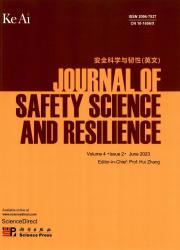Numerical study on flashover in aircraft cargo under varying pressure and ventilation conditions
IF 3.4
Q1 PUBLIC, ENVIRONMENTAL & OCCUPATIONAL HEALTH
引用次数: 0
Abstract
A numerical simulation study was conducted to analyze flashover in a full-scale aircraft cargo compartment, utilizing FDS (Fire Dynamics Simulator) and PyroSim (visual modeling) software. The study aims to: (i) examine how varying heat release rates (HRR), pressures, and vent sizes influence the hot gas layer temperature during flashover in confined spaces, and (ii) establish a semi-empirical model to predict flashover. Experimental results indicate that when the vent size is 1.86 m × 1.06 m and the pressure is 101 kPa, the minimum hot gas layer temperature required to trigger flashover is approximately 410 °C. When the pressure is reduced to 80 kPa and 60 kPa, the critical temperature increases to approximately 436 °C and 460 °C, respectively. These findings provide critical temperature benchmarks for predicting flashover in aircraft cargo fires. Furthermore, a semi-empirical engineering calculation model was developed to predict the hot gas layer temperature under various conditions during flashover. Validation against experimental data from the literature demonstrated good agreement (deviation of ≈20 %), confirming the model's applicability in diverse scenarios.
变压力和变通风条件下飞机货舱闪络的数值研究
利用FDS (Fire Dynamics Simulator)和PyroSim (visual modeling)软件对某飞机货舱的闪络现象进行了数值模拟研究。本研究旨在:(i)研究不同的热释放率(HRR)、压力和通风口尺寸对密闭空间闪络过程中热气体层温度的影响;(ii)建立一个半经验模型来预测闪络。实验结果表明,当通风口尺寸为1.86 m × 1.06 m,压力为101 kPa时,触发闪络所需的最低热气层温度约为410℃。当压力降至80kpa和60kpa时,临界温度分别约为436℃和460℃。这些发现为预测飞机货物火灾中的闪络提供了关键的温度基准。在此基础上,建立了半经验工程计算模型,对闪络过程中不同工况下的热气体层温度进行了预测。根据文献中的实验数据进行验证,结果显示出良好的一致性(偏差约为20%),证实了该模型在不同场景下的适用性。
本文章由计算机程序翻译,如有差异,请以英文原文为准。
求助全文
约1分钟内获得全文
求助全文
来源期刊

安全科学与韧性(英文)
Management Science and Operations Research, Safety, Risk, Reliability and Quality, Safety Research
CiteScore
8.70
自引率
0.00%
发文量
0
审稿时长
72 days
 求助内容:
求助内容: 应助结果提醒方式:
应助结果提醒方式:


